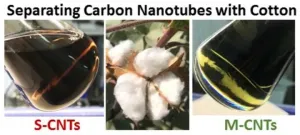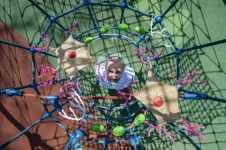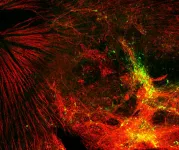Cotton wool proves effective in separating single-wall carbon nanotubes
A joint paper by Kazan Federal University and YTC America appeared in early access in Carbon.
2021-04-19
(Press-News.org) The project was kickstarted in 2017 when a delegation of YTC America (subsidiary of Yazaki Corporation) visited Kazan Federal University. During the talks, YTC suggested that KFU participate in developing effective methods of separating single-wall carbon nanotubes (SWCNTs) into metallic and semiconducting specimens. This was to be done on Tuball tubes produced by OCSiAl, since they are the only ones currently available in industrial quantities.
Carbon nanotubes (CNT) is a family of 1D nanostructures with numerous verified applications, made possible due to their excellent mechanical, optical and conductive properties.
However, application of CNTs is hampered by the presence of species with various structures in the raw production mixture, which obscures unique properties of individual species.
There are various methods for separating CNTs, but they can be hardly scaled up mainly because of the high cost of the used reagents. Notably, most of these methods were originally developed for sorting proteins, and were only recently adopted for separating CNTs.
In this paper, the authors propose a new, cost effective separation method, suitable for the industrial scale processing of CNTs. The method of separation is based on passing the CNTs surfactant solution through a column filled with chemically modified cotton wool.
One of the existing methods of separation, referred to as selective gel permeation, in its essence is a basic column chromatography. Namely, the CNTs surfactant solution is passed through a column, filled with beaded gels of agarose and/or dextran with the trade names "Sepharose" and "Sephacryl". Both agarose and dextran are polysaccharides made from the glucose or glucose-like building units. Cellulose is a natural polysaccharide consisting of the same structural units. This is why the team decided to try this material as a column filler for selective permeation. Cotton is natural cellulose, possessing high surface area due to the fibrous structure. Co-author Timur Khamidullin, a PhD student in Ayrat Dimiev's group (Laboratory of Advanced Carbon Nanomaterials, Kazan Federal University) made the first try with natural cotton wool purchased at a local pharmacy. Despite low sorting efficiency, there was some registered separation, i.e. cotton worked as a column filler. Inspired by the result, Ayrat Dimiev decided to chemically modify the cotton wool to change the chemical nature of its surface. Results were even higher that the expectations: this gave much better separating efficiency from the first very trial. It took another year and half of the collective group efforts to fine-tune both chemical modification of cotton, and the surfactants' ratio in dispersing and eluting solutions.
The use of modified cotton wool allowed to achieve a level of separation which was never reported for Tuball CNTs before. In addition, modified cotton wool is about 200 times cheaper than the agarose- and dextran-based hydrogels, currently employed in the selective gel permeation separation method. The method's scalability is limited only by the diameter of the separation column.
The main contribution to the work was made by group leader Ayrat Dimiev, PhD student Timur Khamidullin, and postdocs Shamil Galyaltdinov and Artur Khannanov.
In the raw production mixture, CNTs of different structures and properties obscure each other's value. Industrial demand for separated CNTs will appear and grow in the coming years. CNTs with metallic type conductivity can be used in flexible transparent conductive films and even potentially replace metals in wiring. Semiconducting CNTs can be used as transistors and as platforms for imaging and targeted drug delivery due to their distinct and unique emission in the IR region. Thus, efficient methods for separating raw CNT production mixtures would raise application of CNTs on a new scientific and technological level. Moreover, the availability of ready-made separated nanotubes will spur the search for new directions of their application.
The main area of future work is to further increase the efficiency of separation by fine-tuning the separation process parameters and the structure of the modified cotton wool. The optimal structure of the modified cotton wool and the conditions for its production are still not fully understood; this question needs to be fully resolved. After this is achieved, the process should be scaled to industrial quantities, and separated nanotubes with various types of conductivity should be tested for practical solutions.
The paper has been made available online and is set to appear in print in June 2021.
INFORMATION:
[Attachments] See images for this press release:

ELSE PRESS RELEASES FROM THIS DATE:
2021-04-19
A recent study finds that social inequality persists, regardless of educational achievement - particularly for men.
"Education is not the equalizer that many people think it is," says Anna Manzoni, author of the study and an associate professor of sociology at North Carolina State University.
The study aimed to determine the extent to which a parent's social status gives an advantage to their children. The research used the educational achievements of parents as a proxy for social status, and looked at the earnings of adult children as a proxy for professional success.
To ...
2021-04-19
ADELPHI, Md. -- Spoken dialogue is the most natural way for people to interact with complex autonomous agents such as robots. Future Army operational environments will require technology that allows artificial intelligent agents to understand and carry out commands and interact with them as teammates.
Researchers from the U.S. Army Combat Capabilities Development Command, known as DEVCOM, Army Research Laboratory and the University of Southern California's Institute for Creative Technologies, a Department of Defense-sponsored University Affiliated Research Center, created an approach to flexibly interpret and respond to Soldier intent derived from spoken dialogue with autonomous systems.
This technology is currently the primary ...
2021-04-19
The Andes Mountains of South America are the most species-rich biodiversity hotspot for plant and vertebrate species in the world. But the forest that climbs up this mountain range provides another important service to humanity.
Andean forests are helping to protect the planet by acting as a carbon sink, absorbing carbon dioxide and keeping some of this climate-altering gas out of circulation, according to new research published in Nature Communications.
The study -- which draws upon two decades of data from 119 forest-monitoring plots in Colombia, Ecuador, Peru, Bolivia and Argentina -- was produced by an international team of scientists including researchers supported by the Living Earth Collaborative at Washington University in St. Louis. The lead author was Alvaro Duque from the ...
2021-04-19
A team of scientists from Russia studied the role of double-stranded fragments of the maturing RNA and showed that the interaction between distant parts of the RNA can regulate gene expression. The research was published in Nature Communications.
At school, we learn that DNA is double-stranded and RNA is single-stranded, but that is not entirely true. Scientists have encountered many cases of RNA forming a double-stranded (a.k.a. secondary) structure that plays an important role in the functioning of RNA molecules. These structures are involved in the regulation of gene expression, where the double-stranded regions typically carry specific functions and, if lost, may cause severe disorders. A double-stranded structure is created by sticky complementary ...
2021-04-19
New, detailed study of the Renland Ice Cap offers the possibility of modelling other smaller ice caps and glaciers with significantly greater accuracy than hitherto. The study combined airborne radar data to determine the thickness of the ice cap with on-site measurements of the thickness of the ice cap and satellite data. Researchers from the Niels Bohr Institute - University of Copenhagen gathered the data from the ice cap in 2015, and this work has now come to fruition in the form of more exact predictions of local climate conditions.
The accuracy ...
2021-04-19
A new study led by researchers at Johns Hopkins and the University of Pennsylvania uses computer modeling to suggest that eviction bans authorized during the COVID-19 pandemic reduced the infection rate and not only protected those who would have lost their housing but also entire communities from the spread of infections.
With widespread job loss in the U.S. during the pandemic, many state and local governments temporarily halted evictions last spring, and just as these protections were about to expire in September, the Centers for Disease Control ...
2021-04-19
Alzheimer's disease (AD) is a form of progressive dementia interfering with daily living. It is caused by the decline in the number of brain cells resulting in the deterioration of our mental abilities. One of the main reasons for the worsening brain cells condition and even the brain shrinkage are molecules having a specific structure called β-amyloids (Aβ). They are peptides that tend to agglomerate around the nerve cells, becoming toxic and damage them. Recent studies, presented by scientists from the Institute of Physical Chemistry, Polish Academy of Sciences, led by dr. Piotr Pieta, give hope for inhibition of the β-amyloids' toxicity by applying the K162 molecule. Researchers present a tremendous protective impact on the biological membranes ...
2021-04-19
UPTON, NY--Scientists have identified the primary cause of failure in a state-of-the-art lithium-metal battery, of interest for long-range electric vehicles. Using high-energy x-rays, they followed the cycling-induced changes at thousands of different points across the battery and mapped the variations in performance. At each point, they used the x-ray data to calculate the amount of cathode material and its local state of charge. These findings, combined with complementary electrochemical measurements, enabled them to determine the dominant mechanism driving the loss of ...
2021-04-19
A joint research carried out by MIPT scientists and Harvard researchers have presented retinal cells that can integrate into the retina. This is the first successful attempt to transplant ganglion cells (retinal neurons that are destroyed by glaucoma) derived from stem cells in a lab setting. Scientists tested the technology in mice and established that the cells successfully integrated and survived for a year. In the future, the researchers plan to create specialized cell banks, which will permit individual, tailored therapy for each patient.
The world's first successful attempt to grow and transplant ...
2021-04-19
COVID-19 patients who are overweight or obese are more likely to develop a more severe infection than patients of healthy weight, and they require oxygen and invasive mechanical ventilation more often. There is no increased risk of death . These conclusions, for which more than 7,000 patients were studied, appear from international research in eleven countries, including the Netherlands (Radboud university medical center).
The study, led by Australian researchers, examined over 7000 patients from eleven different countries who were admitted to 18 hospitals. Of this group, over a third (34.8%) were overweight and almost a third (30.8%) were obese. COVID-19 patients with obesity required ...
LAST 30 PRESS RELEASES:
[Press-News.org] Cotton wool proves effective in separating single-wall carbon nanotubes
A joint paper by Kazan Federal University and YTC America appeared in early access in Carbon.






